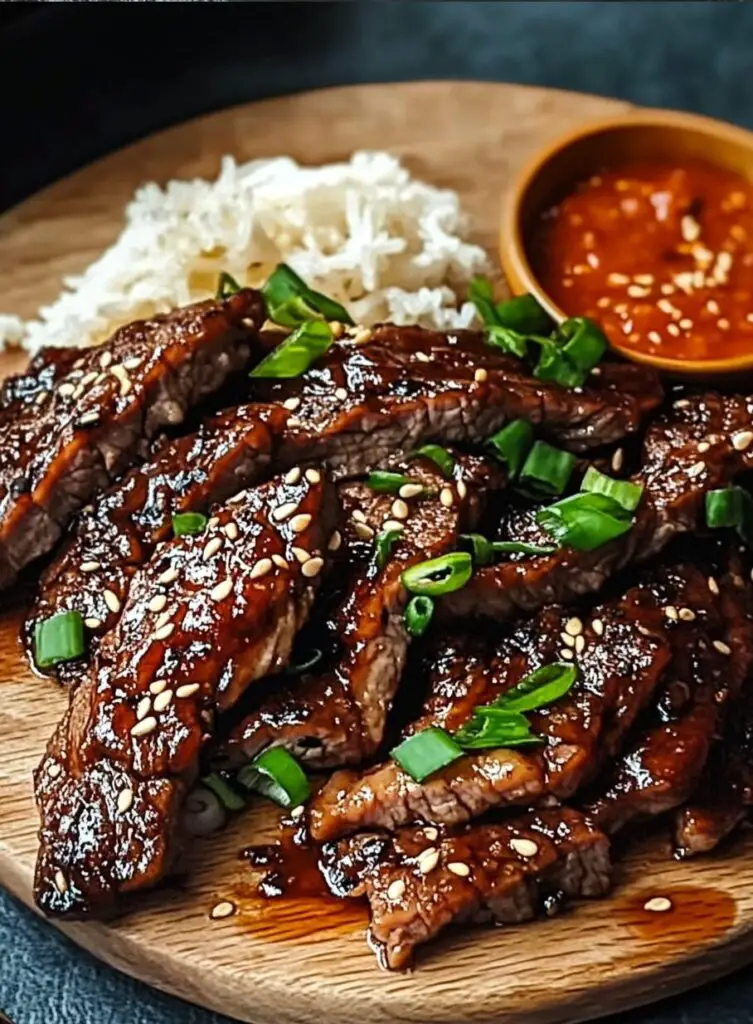Bulgogi, meaning “fire meat,” is a beloved Korean dish known for its savory, slightly sweet, and smoky flavors. Traditionally made with premium cuts like ribeye, this version uses tri-tip for an economical yet flavorful twist. With a tenderizing marinade of soy, pear, and ginger, this dish balances authentic Korean ingredients with a modern approach, perfect for any dinner setting.
Ingredients:
- 1 pear
- 1 onion
- 1-inch piece fresh ginger
- ½ cup soy sauce
- 2 garlic cloves
- 1 tri-tip beef, thinly sliced against the grain
- 1 tablespoon grapeseed oil
- 1 tablespoon gochujang (Korean chili paste)
- 1 tablespoon rice vinegar
- 1 tablespoon white sugar
- ½ cup water
- Salt and pepper, to taste
- 1 tablespoon sesame oil
- 1 tablespoon sesame seeds
- Cooked rice (for serving)
- Kimchi (for serving)
- Steamed vegetables (for serving)
- Sliced scallions (for garnish)
Directions:
- Make the Marinade: Blend the pear, onion, ginger, ½ cup soy sauce, and garlic cloves in a blender or food processor until smooth.
- Marinate the Meat: Place the thinly sliced tri-tip in a resealable plastic bag, add the marinade, and refrigerate for at least 4 hours or overnight for enhanced flavor.
- Cook the Meat: Heat grapeseed oil in a skillet over medium-high heat. Sear the meat for about 1 minute on each side until charred. Remove from the pan.
- Prepare the Sauce: In the same skillet, combine gochujang, rice vinegar, soy sauce, sugar, minced garlic, ginger, and ½ cup water. Simmer for 3 minutes while stirring.
- Finish Cooking: Add the seared meat back to the pan and simmer in the sauce for 1-2 minutes until heated through. Season with salt and pepper to taste.
- Serve: Drizzle sesame oil and sprinkle sesame seeds over the bulgogi. Serve with rice, kimchi, and steamed vegetables. Garnish with sliced scallions.
Nutritional Information (Per Serving):
- Calories: 320-400 (depending on portion size and sides)
- Protein: 25g
- Carbohydrates: 15g (from rice and marinade)
- Fat: 18g (including sesame oil and beef fat)
Enjoy this fusion of Korean tradition and Western-style innovation for a flavorful, satisfying meal!
Bulgogi with a Twist: A Fusion of Korean Tradition and Modern Simplicity
Bulgogi, translating to “fire meat,” holds a cherished spot in Korean cuisine, celebrated for its rich, smoky, and slightly sweet profile. This dish, steeped in history, has evolved over centuries from royal delicacies to a global comfort food phenomenon. In this recipe, the traditional allure of bulgogi meets an economical and modern twist by substituting tri-tip for pricier cuts like ribeye, creating a dish that’s both accessible and deeply satisfying.
The Cultural Roots of Bulgogi
The history of bulgogi dates back to the Goguryeo era (37 BC–668 AD), when it was known as “maekjeok,” and meat was grilled on skewers over open flames. Over the centuries, bulgogi transitioned into a marinated dish, reflecting Korea’s evolving culinary techniques and the influence of regional flavors. Today, it is a staple in Korean households and restaurants, served as both a celebratory dish and a casual meal.
The term “fire meat” doesn’t just refer to its cooking method but also captures the lively, communal essence of Korean dining. Bulgogi is often cooked and enjoyed at the table, bringing people together to share stories, laughter, and a love for food.
A Modern Take with Tri-Tip
Traditionally, premium cuts like ribeye or sirloin are used for bulgogi, prized for their tenderness and marbling. This recipe takes a practical approach, opting for tri-tip, a cut known for its flavor and affordability. While tri-tip requires careful slicing against the grain for optimal tenderness, it absorbs marinades exceptionally well, ensuring a dish that doesn’t compromise on taste.
The use of tri-tip aligns with the global movement toward making traditional recipes more accessible without losing their essence. For home cooks, this adjustment opens the doors to creating restaurant-quality bulgogi on a budget.
The Magic of the Marinade
At the heart of bulgogi lies its marinade—a perfect harmony of salty, sweet, and umami flavors. This recipe employs a blend of soy sauce, fresh pear, onion, garlic, and ginger. The pear, a quintessential element in Korean marinades, acts as a natural tenderizer while adding a subtle sweetness. Combined with soy sauce and aromatics, the marinade transforms the tri-tip into a flavorful, tender masterpiece.
The inclusion of gochujang (Korean chili paste) in the sauce adds a gentle heat and depth, catering to those who enjoy a hint of spice. Balancing this with rice vinegar and sugar ensures a multi-dimensional flavor profile that delights the palate.
Cooking Techniques for Success
The cooking process for bulgogi is straightforward but requires attention to detail for the best results. Searing the marinated beef over high heat caramelizes the natural sugars, creating a smoky char that’s signature to the dish. By simmering the meat briefly in a rich sauce, the flavors are further intensified, resulting in a dish that’s irresistibly savory.
The use of sesame oil and seeds as a finishing touch enhances the nutty aroma, while garnishing with scallions adds freshness and color, completing the dish’s presentation.
Serving Suggestions
Bulgogi’s versatility extends beyond its preparation to how it’s served. Traditionally paired with steamed rice, it’s also commonly accompanied by:
- Kimchi: The tangy, spicy notes of fermented vegetables perfectly complement the richness of bulgogi.
- Steamed Vegetables: Lightly steamed broccoli, carrots, or bok choy add balance and texture to the meal.
- Leafy Greens: Wrap bulgogi in lettuce or perilla leaves for a refreshing bite, often enhanced with ssamjang (a savory dipping sauce).
For a modern flair, bulgogi can also be used as a filling for tacos, sandwiches, or rice bowls, showcasing its adaptability to global cuisines.
Health and Nutritional Highlights
Despite its indulgent flavors, bulgogi can fit into a balanced diet. Tri-tip is a leaner cut of beef, offering high-quality protein and essential nutrients like iron and zinc. The marinade’s ingredients, including ginger and garlic, bring potential health benefits, such as anti-inflammatory and antioxidant properties.
To make the dish even lighter, consider reducing the sugar or substituting it with natural sweeteners like honey. Pairing it with fiber-rich sides, like brown rice or quinoa, and fresh vegetables can enhance its nutritional value while maintaining its traditional appeal.
Why This Recipe Works
This recipe bridges the gap between authentic Korean flavors and modern practicality. By using tri-tip, it makes bulgogi more accessible to a wider audience without compromising on the dish’s core identity. The marinade, with its thoughtful blend of traditional and contemporary ingredients, ensures a flavor-packed experience that’s both nostalgic and innovative.
Conclusion
Bulgogi, with its tantalizing flavors and rich cultural history, continues to capture hearts worldwide. This tri-tip version brings the essence of Korean cuisine into modern kitchens, offering a dish that’s both economical and exquisite. Whether you’re new to Korean cooking or a seasoned enthusiast, this recipe is a celebration of culinary heritage and innovation. Paired with classic accompaniments or creative sides, it promises a dining experience that’s as memorable as it is delicious.
Print
Tri-Tip Bulgogi
Description
Bulgogi, meaning “fire meat,” is a beloved Korean dish known for its savory, slightly sweet, and smoky flavors. Traditionally made with premium cuts like ribeye, this version uses tri-tip for an economical yet flavorful twist. With a tenderizing marinade of soy, pear, and ginger, this dish balances authentic Korean ingredients with a modern approach, perfect for any dinner setting.
Ingredients
- 1 pear
- 1 onion
- 1-inch piece fresh ginger
- 1/2 cup soy sauce
- 2 garlic cloves
- 1 tri-tip beef, thinly sliced against the grain
- 1 tablespoon grapeseed oil
- 1 tablespoon gochujang (Korean chili paste)
- 1 tablespoon rice vinegar
- 1 tablespoon white sugar
- 1/2 cup water
- Salt and pepper, to taste
- 1 tablespoon sesame oil
- 1 tablespoon sesame seeds
- Cooked rice (for serving)
- Kimchi (for serving)
- Steamed vegetables (for serving)
- Sliced scallions (for garnish)
Instructions
- Make the Marinade: Blend the pear, onion, ginger, ½ cup soy sauce, and garlic cloves in a blender or food processor until smooth.
- Marinate the Meat: Place the thinly sliced tri-tip in a resealable plastic bag, add the marinade, and refrigerate for at least 4 hours or overnight for enhanced flavor.
- Cook the Meat: Heat grapeseed oil in a skillet over medium-high heat. Sear the meat for about 1 minute on each side until charred. Remove from the pan.
- Prepare the Sauce: In the same skillet, combine gochujang, rice vinegar, soy sauce, sugar, minced garlic, ginger, and ½ cup water. Simmer for 3 minutes while stirring.
- Finish Cooking: Add the seared meat back to the pan and simmer in the sauce for 1-2 minutes until heated through. Season with salt and pepper to taste.
- Serve: Drizzle sesame oil and sprinkle sesame seeds over the bulgogi. Serve with rice, kimchi, and steamed vegetables. Garnish with sliced scallions.
Nutrition
- Calories: 320-400 (depending on portion size and sides)







